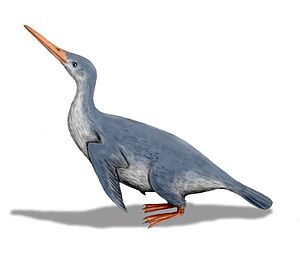Waimanu facts for kids
Quick facts for kids Waimanu |
|
|---|---|
 |
|
| Scientific classification |
|
| Kingdom: | Animalia |
| Phylum: | Chordata |
| Class: | Aves |
| Order: | Sphenisciformes |
| Genus: | †Waimanu Slack and others 2006 |
| Type species | |
| †Waimanu manneringi |
|
Waimanu was a very old type of penguin. It lived about 61 to 60 million years ago. This was right after the big event that caused the dinosaurs to disappear. Waimanu was about the same size as a modern Emperor penguin, which is about 1 meter (3 feet) tall.
This ancient bird is very important to scientists. It helps us understand how birds first developed. It also shows us how penguins became the amazing swimmers they are today. Waimanu is special because it lived so long ago. It also helps us see where penguins fit in the bird family tree.
What Waimanu Looked Like
Waimanu was an early member of the penguin family. Like modern penguins, it probably could not fly. Its wings were made for swimming underwater. But its wing bones were not as specialized as those of today's penguins. Modern penguins have very strong, flat wings for diving.
Waimanu might have looked a bit like a flightless loon. Loons are birds that dive for fish. It might also have moved like the great auk. The great auk was a large, flightless bird that lived in the ocean. Scientists think penguins and loons are closely related. Penguins use their wings to swim underwater. Loons use their feet to swim and dive.
Discovery of Waimanu
Waimanu was found in New Zealand in 1980. It was discovered near the Waipara River in the Canterbury Region. The fossil was found in a type of rock called the Basal Waipara Greensand.
The main fossil, called the holotype, is a partial skeleton. It includes parts of its leg bones, hip, and spine. This important fossil is kept at the Canterbury Museum in New Zealand.
Why Waimanu is Important
The discovery of Waimanu helped scientists learn more about birds. It helped answer a big question. Did modern birds appear before the dinosaurs died out? Or did they appear very quickly right after?
Studies of bird DNA and fossils like Waimanu suggest the second idea. It seems that many modern birds developed very fast after the dinosaurs were gone. Waimanu is a key piece of this puzzle. It shows that penguins were around very early in bird history.
See also
 In Spanish: Waimanu para niños
In Spanish: Waimanu para niños

